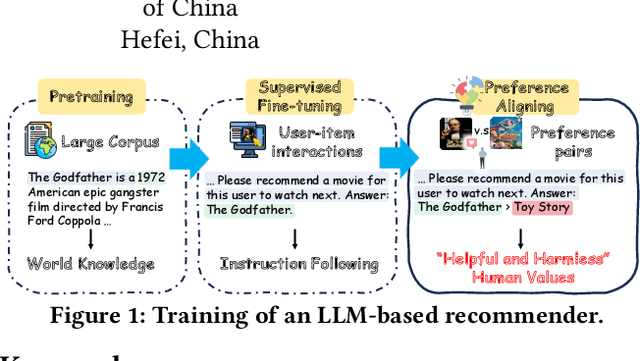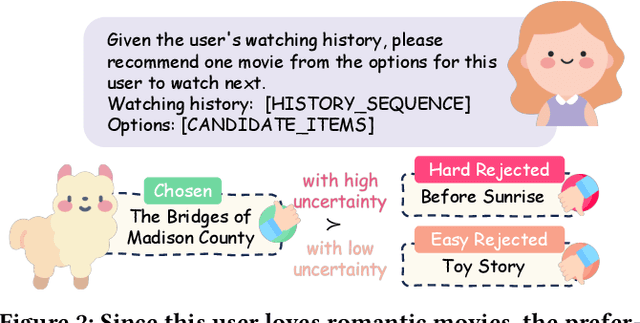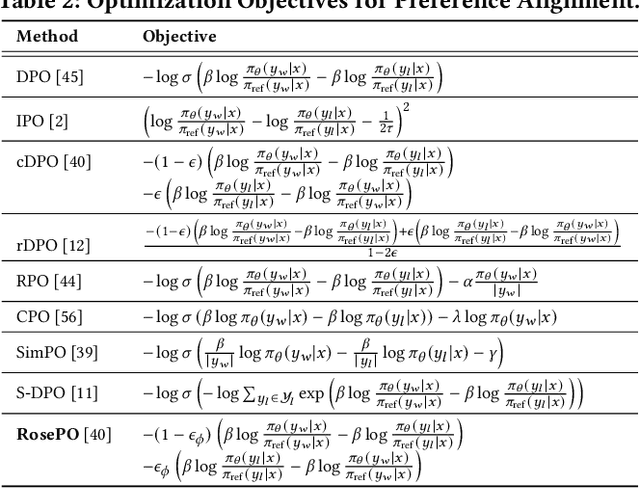Yancheng Yuan
Enhancing Input-Label Mapping in In-Context Learning with Contrastive Decoding
Feb 19, 2025Abstract:Large language models (LLMs) excel at a range of tasks through in-context learning (ICL), where only a few task examples guide their predictions. However, prior research highlights that LLMs often overlook input-label mapping information in ICL, relying more on their pre-trained knowledge. To address this issue, we introduce In-Context Contrastive Decoding (ICCD), a novel method that emphasizes input-label mapping by contrasting the output distributions between positive and negative in-context examples. Experiments on 7 natural language understanding (NLU) tasks show that our ICCD method brings consistent and significant improvement (up to +2.1 improvement on average) upon 6 different scales of LLMs without requiring additional training. Our approach is versatile, enhancing performance with various demonstration selection methods, demonstrating its broad applicability and effectiveness. The code and scripts will be publicly released.
A Survey on Large Language Model-based Agents for Statistics and Data Science
Dec 18, 2024Abstract:In recent years, data science agents powered by Large Language Models (LLMs), known as "data agents," have shown significant potential to transform the traditional data analysis paradigm. This survey provides an overview of the evolution, capabilities, and applications of LLM-based data agents, highlighting their role in simplifying complex data tasks and lowering the entry barrier for users without related expertise. We explore current trends in the design of LLM-based frameworks, detailing essential features such as planning, reasoning, reflection, multi-agent collaboration, user interface, knowledge integration, and system design, which enable agents to address data-centric problems with minimal human intervention. Furthermore, we analyze several case studies to demonstrate the practical applications of various data agents in real-world scenarios. Finally, we identify key challenges and propose future research directions to advance the development of data agents into intelligent statistical analysis software.
One Shot, One Talk: Whole-body Talking Avatar from a Single Image
Dec 02, 2024Abstract:Building realistic and animatable avatars still requires minutes of multi-view or monocular self-rotating videos, and most methods lack precise control over gestures and expressions. To push this boundary, we address the challenge of constructing a whole-body talking avatar from a single image. We propose a novel pipeline that tackles two critical issues: 1) complex dynamic modeling and 2) generalization to novel gestures and expressions. To achieve seamless generalization, we leverage recent pose-guided image-to-video diffusion models to generate imperfect video frames as pseudo-labels. To overcome the dynamic modeling challenge posed by inconsistent and noisy pseudo-videos, we introduce a tightly coupled 3DGS-mesh hybrid avatar representation and apply several key regularizations to mitigate inconsistencies caused by imperfect labels. Extensive experiments on diverse subjects demonstrate that our method enables the creation of a photorealistic, precisely animatable, and expressive whole-body talking avatar from just a single image.
Unified Parameter-Efficient Unlearning for LLMs
Nov 30, 2024Abstract:The advent of Large Language Models (LLMs) has revolutionized natural language processing, enabling advanced understanding and reasoning capabilities across a variety of tasks. Fine-tuning these models for specific domains, particularly through Parameter-Efficient Fine-Tuning (PEFT) strategies like LoRA, has become a prevalent practice due to its efficiency. However, this raises significant privacy and security concerns, as models may inadvertently retain and disseminate sensitive or undesirable information. To address these issues, we introduce a novel instance-wise unlearning framework, LLMEraser, which systematically categorizes unlearning tasks and applies precise parameter adjustments using influence functions. Unlike traditional unlearning techniques that are often limited in scope and require extensive retraining, LLMEraser is designed to handle a broad spectrum of unlearning tasks without compromising model performance. Extensive experiments on benchmark datasets demonstrate that LLMEraser excels in efficiently managing various unlearning scenarios while maintaining the overall integrity and efficacy of the models.
RosePO: Aligning LLM-based Recommenders with Human Values
Oct 16, 2024



Abstract:Recently, there has been a growing interest in leveraging Large Language Models (LLMs) for recommendation systems, which usually adapt a pre-trained LLM to the recommendation scenario through supervised fine-tuning (SFT). However, both the pre-training and SFT stages fail to explicitly model the comparative relationships of a user's preferences on different items. To construct a "helpful and harmless" LLM-based recommender, we propose a general framework -- Recommendation with smoothing personalized Preference Optimization (RosePO), which better aligns with customized human values during the post-training stage. Specifically, in addition to the input and chosen response that naturally align with SFT data, we design a rejected sampling strategy tailored for enhancing helpfulness, along with two strategies aimed at mitigating biases to promote harmlessness. To ensure robustness against uncertain labels present in automatically constructed preference data, we introduce a personalized smoothing factor predicted by a preference oracle into the optimization objective. Evaluation on three real-world datasets demonstrates the effectiveness of our method, showcasing not only improved recommendation performance but also mitigation of semantic hallucination and popularity bias.
Adaptive Self-supervised Robust Clustering for Unstructured Data with Unknown Cluster Number
Jul 29, 2024



Abstract:We introduce a novel self-supervised deep clustering approach tailored for unstructured data without requiring prior knowledge of the number of clusters, termed Adaptive Self-supervised Robust Clustering (ASRC). In particular, ASRC adaptively learns the graph structure and edge weights to capture both local and global structural information. The obtained graph enables us to learn clustering-friendly feature representations by an enhanced graph auto-encoder with contrastive learning technique. It further leverages the clustering results adaptively obtained by robust continuous clustering (RCC) to generate prototypes for negative sampling, which can further contribute to promoting consistency among positive pairs and enlarging the gap between positive and negative samples. ASRC obtains the final clustering results by applying RCC to the learned feature representations with their consistent graph structure and edge weights. Extensive experiments conducted on seven benchmark datasets demonstrate the efficacy of ASRC, demonstrating its superior performance over other popular clustering models. Notably, ASRC even outperforms methods that rely on prior knowledge of the number of clusters, highlighting its effectiveness in addressing the challenges of clustering unstructured data.
LAMBDA: A Large Model Based Data Agent
Jul 24, 2024Abstract:We introduce ``LAMBDA," a novel open-source, code-free multi-agent data analysis system that that harnesses the power of large models. LAMBDA is designed to address data analysis challenges in complex data-driven applications through the use of innovatively designed data agents that operate iteratively and generatively using natural language. At the core of LAMBDA are two key agent roles: the programmer and the inspector, which are engineered to work together seamlessly. Specifically, the programmer generates code based on the user's instructions and domain-specific knowledge, enhanced by advanced models. Meanwhile, the inspector debugs the code when necessary. To ensure robustness and handle adverse scenarios, LAMBDA features a user interface that allows direct user intervention in the operational loop. Additionally, LAMBDA can flexibly integrate external models and algorithms through our knowledge integration mechanism, catering to the needs of customized data analysis. LAMBDA has demonstrated strong performance on various machine learning datasets. It has the potential to enhance data science practice and analysis paradigm by seamlessly integrating human and artificial intelligence, making it more accessible, effective, and efficient for individuals from diverse backgrounds. The strong performance of LAMBDA in solving data science problems is demonstrated in several case studies, which are presented at \url{https://www.polyu.edu.hk/ama/cmfai/lambda.html}.
Collective Certified Robustness against Graph Injection Attacks
Mar 03, 2024Abstract:We investigate certified robustness for GNNs under graph injection attacks. Existing research only provides sample-wise certificates by verifying each node independently, leading to very limited certifying performance. In this paper, we present the first collective certificate, which certifies a set of target nodes simultaneously. To achieve it, we formulate the problem as a binary integer quadratic constrained linear programming (BQCLP). We further develop a customized linearization technique that allows us to relax the BQCLP into linear programming (LP) that can be efficiently solved. Through comprehensive experiments, we demonstrate that our collective certification scheme significantly improves certification performance with minimal computational overhead. For instance, by solving the LP within 1 minute on the Citeseer dataset, we achieve a significant increase in the certified ratio from 0.0% to 81.2% when the injected node number is 5% of the graph size. Our step marks a crucial step towards making provable defense more practical.
Revisiting Demonstration Selection Strategies in In-Context Learning
Jan 22, 2024Abstract:Large language models (LLMs) have shown an impressive ability to perform a wide range of tasks using in-context learning (ICL), where a few examples are used to describe a task to the model. However, the performance of ICL varies significantly with the choice of demonstrations, and it is still unclear why this happens or what factors will influence its choice. In this work, we first revisit the factors contributing to this variance from both data and model aspects, and find that the choice of demonstration is both data- and model-dependent. We further proposed a data- and model-dependent demonstration selection method, \textbf{TopK + ConE}, based on the assumption that \textit{the performance of a demonstration positively correlates with its contribution to the model's understanding of the test samples}, resulting in a simple and effective recipe for ICL. Empirically, our method yields consistent improvements in both language understanding and generation tasks with different model scales. Further analyses confirm that, besides the generality and stability under different circumstances, our method provides a unified explanation for the effectiveness of previous methods. Code will be released.
XAI for In-hospital Mortality Prediction via Multimodal ICU Data
Dec 29, 2023Abstract:Predicting in-hospital mortality for intensive care unit (ICU) patients is key to final clinical outcomes. AI has shown advantaged accuracy but suffers from the lack of explainability. To address this issue, this paper proposes an eXplainable Multimodal Mortality Predictor (X-MMP) approaching an efficient, explainable AI solution for predicting in-hospital mortality via multimodal ICU data. We employ multimodal learning in our framework, which can receive heterogeneous inputs from clinical data and make decisions. Furthermore, we introduce an explainable method, namely Layer-Wise Propagation to Transformer, as a proper extension of the LRP method to Transformers, producing explanations over multimodal inputs and revealing the salient features attributed to prediction. Moreover, the contribution of each modality to clinical outcomes can be visualized, assisting clinicians in understanding the reasoning behind decision-making. We construct a multimodal dataset based on MIMIC-III and MIMIC-III Waveform Database Matched Subset. Comprehensive experiments on benchmark datasets demonstrate that our proposed framework can achieve reasonable interpretation with competitive prediction accuracy. In particular, our framework can be easily transferred to other clinical tasks, which facilitates the discovery of crucial factors in healthcare research.
 Add to Chrome
Add to Chrome Add to Firefox
Add to Firefox Add to Edge
Add to Edge